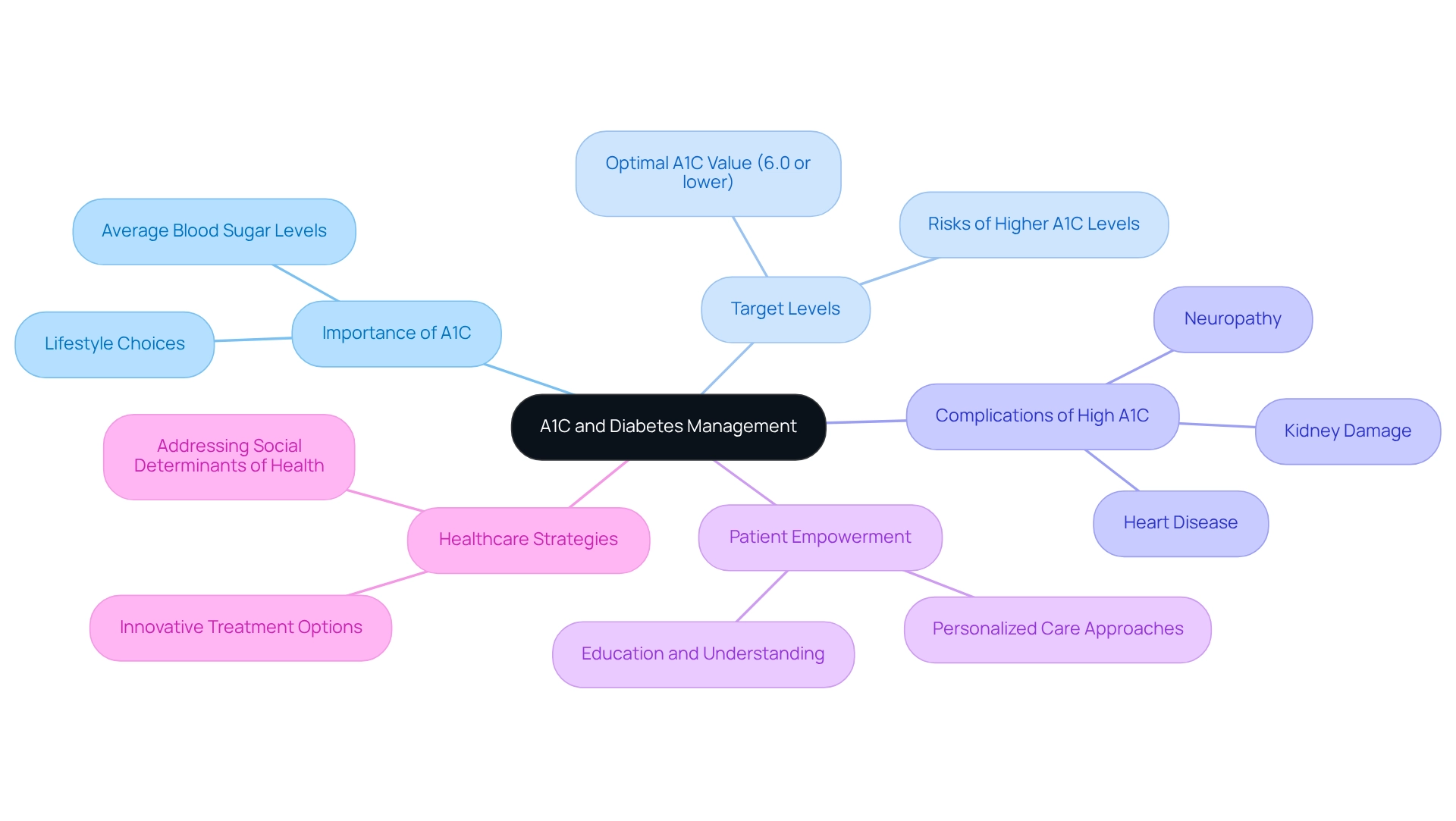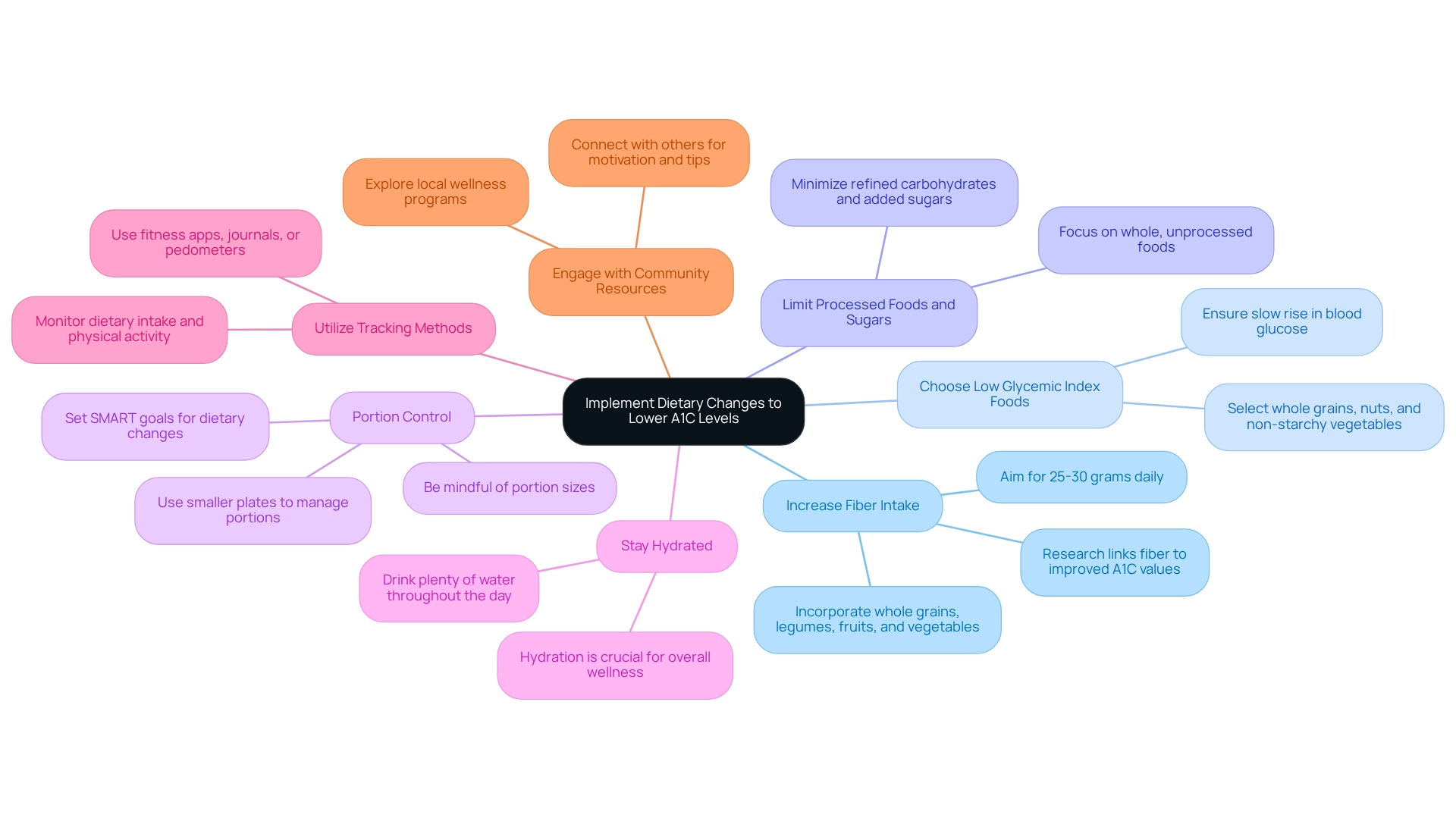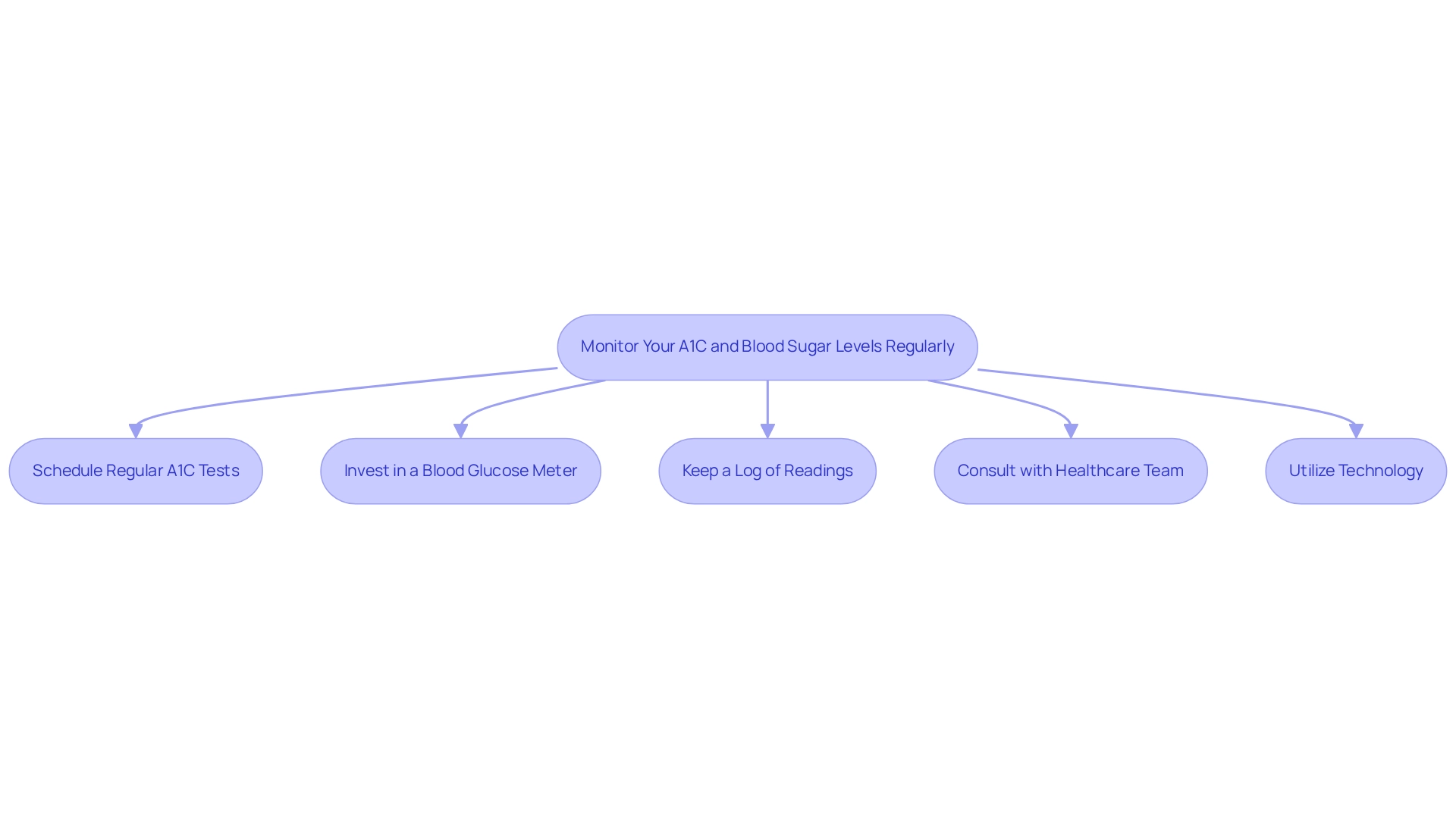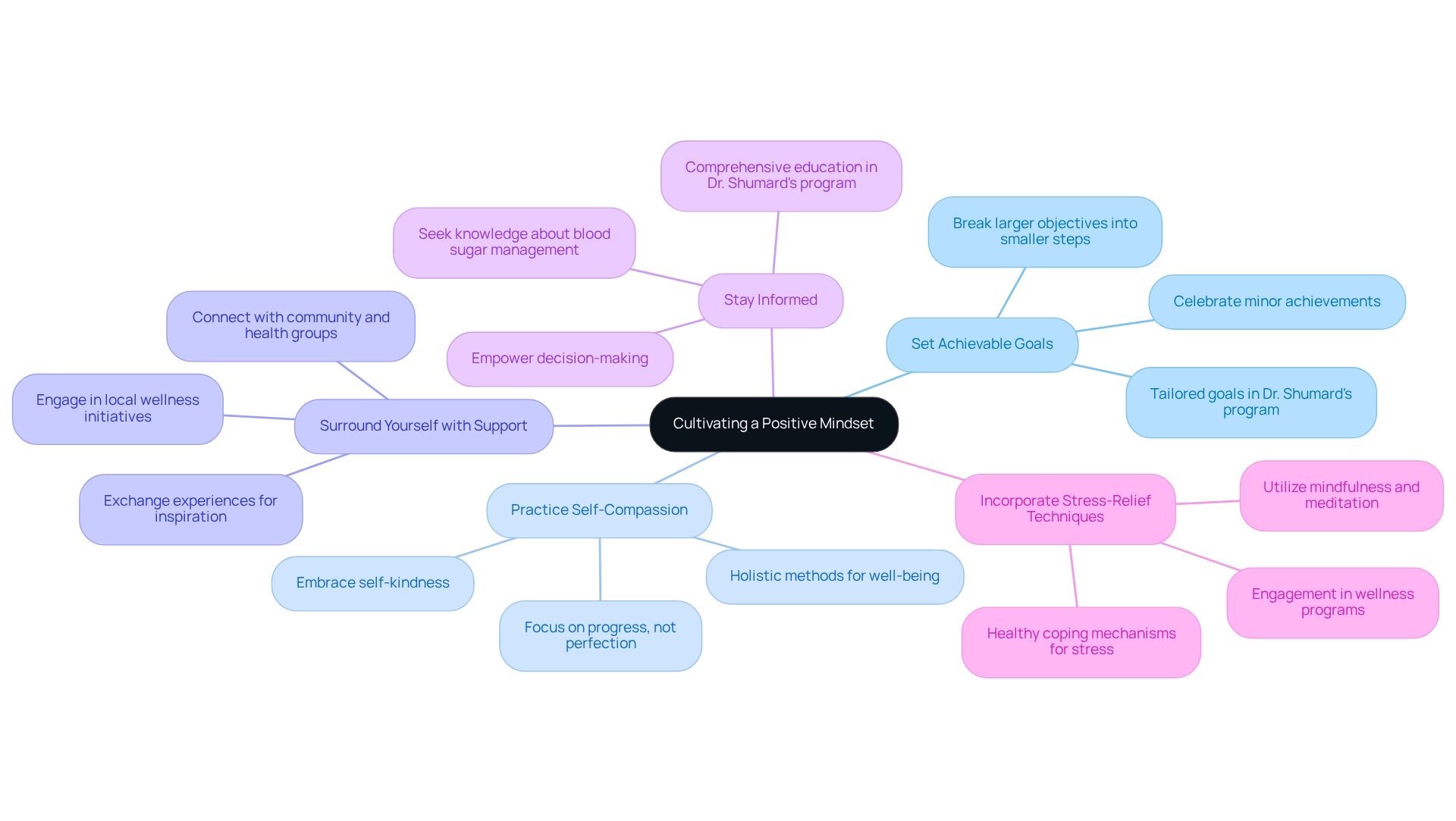Overview
Managing diabetes can be challenging, but aiming for an A1C of 6.0 is a powerful step toward better health. To achieve this goal, it’s essential to make dietary changes, engage in regular exercise, and consistently monitor your A1C and blood sugar levels. Many patients find that incorporating a balanced diet and physical activity into their daily routines not only helps in managing their diabetes but also enhances their overall well-being.
It’s important to recognize that these changes may feel overwhelming at first. However, by breaking them down into manageable steps, you can empower yourself to take control of your health. Regular tracking of your progress is key; it allows you to see the positive impact of your efforts and encourages you to stay committed to your journey.
Consider this: What small changes can you make today that will lead to lasting improvements? Remember, you are not alone in this journey. By embracing these actionable steps, you can effectively manage your diabetes and reduce the risk of complications. Let’s take this journey together, one step at a time.
Introduction
In the journey of managing diabetes, understanding A1C levels is not just important—it’s essential for maintaining your health. The A1C test gives you a comprehensive view of your average blood sugar levels over the past few months, serving as a key indicator of how well you’re managing your diabetes. With projections indicating that over 1.3 billion people could be affected by diabetes by 2050, the need for effective strategies to lower A1C levels is more critical than ever.
Many individuals may feel overwhelmed by their diagnosis, but it’s important to recognize that there are actionable steps you can take to improve your A1C readings. From making dietary modifications and engaging in regular exercise to consistent monitoring and cultivating a positive mindset, every small change can lead to significant improvements. By empowering yourself with knowledge and practical tools, the path to better diabetes management becomes not only achievable but also transformative.
Are you ready to take the first step toward a healthier future? Together, we can explore the ways to make this journey manageable and rewarding.
Understand A1C and Its Importance in Diabetes Management
The A1C test serves as a vital tool in diabetes care, helping you understand your average blood sugar levels over the past two to three months. Aiming for an A1C value of A1C 6.0% or lower is generally optimal, as it indicates effective blood sugar management and significantly lowers the risk of complications such as heart disease, kidney damage, and neuropathy. When you grasp your A1C results, you empower yourself to make informed lifestyle and treatment choices. Regularly tracking your A1C values is crucial, as it offers a comprehensive view of your blood sugar control over time, rather than relying solely on daily glucose readings.
It’s important to recognize that recent studies emphasize the importance of maintaining A1C readings within this target range. Individuals with higher A1C levels face increased risks of diabetes-related complications. With projections indicating that over 1.3 billion people may be affected by this condition by 2050, the need for effective control strategies becomes clear. This is particularly vital, as social determinants of health can significantly impact A1C readings and blood sugar management, especially in food-insecure communities. Furthermore, with concerning statistics revealing that 7,000 incorrect medications are administered to patients in hospitals and 80,000 infections acquired, the urgency for effective diabetes management is heightened.
Many patients find that elevated A1C values can lead to a diminished quality of life due to complications such as neuropathy and cardiovascular issues. For instance, Dr. Jason Shumard’s innovative approach at his center underscores the importance of personalized care and education. He helps patients understand their A1C values and associated risks. One patient shared, “I was on two different meds that weren’t working and was told that I needed insulin. After joining Dr. Shumard’s program, I lost 55 lbs, and my A1C dropped from 9.1 to 5.7.” This dedication to patient empowerment not only enhances quality of life but also reduces dependency on traditional medical interventions. By equipping patients with actionable insights and practical tools, the center cultivates an environment where individuals can reclaim their health and well-being.
If you’re looking for guidance on how to effectively manage your diabetes and improve your A1C results, consider reaching out to the Integrative Wellness Center for personalized support and advice.
Implement Dietary Changes to Lower A1C Levels
To effectively reduce your A1C numbers, it’s essential to prioritize a balanced diet rich in whole foods and implement efficient strategies for progress monitoring and goal establishment. Here are some actionable steps to guide you on this journey:
-
Increase Fiber Intake: Aim for 25-30 grams of fiber daily by incorporating whole grains, legumes, fruits, and vegetables into your meals. Many patients find that increased fiber consumption is linked to enhanced A1C values, as fiber slows glucose absorption, promoting better blood sugar management. It’s significant to note that research indicates raising fiber consumption can greatly affect A1C measurements, emphasizing the importance of dietary modifications in controlling type 2 diabetes.
-
Choose Low Glycemic Index Foods: Select foods with a low glycemic index (GI), such as whole grains, nuts, and non-starchy vegetables. These choices help ensure a slow rise in blood glucose, which is essential for managing blood sugar conditions.
-
Limit Processed Foods and Sugars: It’s wise to minimize your consumption of refined carbohydrates and added sugars found in sweets, sugary drinks, and processed snacks. Instead, focus on whole, unprocessed foods that provide essential nutrients without the harmful effects of excess sugar.
-
Portion Control: Being mindful of portion sizes can prevent overeating, which may cause spikes in blood sugar. Utilizing smaller plates can be an effective strategy for managing portions while maintaining a balanced diet. Additionally, setting SMART goals—specific, measurable, attainable, relevant, and time-bound—can enhance your focus and motivation in achieving dietary changes.
-
Stay Hydrated: Remember to ensure adequate hydration by drinking plenty of water throughout the day. Staying hydrated is crucial for overall wellness and can help in controlling blood sugar effectively.
-
Utilize Tracking Methods: Consider using fitness apps, journals, or pedometers to monitor your dietary intake and physical activity. These tools can help you stay accountable and make necessary adjustments to your routine.
-
Engage with Community Resources: Explore local community wellness programs in San Marcos that provide assistance and resources for managing blood sugar levels. Connecting with others who share similar health goals can provide motivation and practical tips for integrating healthy habits into your daily life.
Integrating these nutritional modifications, including an alc 6.0 approach, can significantly influence your A1C readings, as demonstrated by many success stories from individuals who have improved their blood sugar management through conscious eating and lifestyle changes. As Andrew Nathan Reynolds notes, “One practical way to increase fiber intakes is to replace refined grain products with whole grain foods.” This method not only promotes improved A1C results but also aligns with ongoing research highlighting the necessity for new strategies to address type 2 conditions, especially through dietary habits and lifestyle modifications.
Incorporate Regular Exercise into Your Routine
Including regular exercise in your routine can greatly reduce your A1C values. It’s important to recognize that starting this journey can feel overwhelming, but here’s how to get started, as outlined in the walking program PDF:
-
Set Realistic Goals: Aim for at least 150 minutes of moderate-intensity aerobic activity each week, such as brisk walking, swimming, or cycling. Breaking this down into manageable sessions, like 30 minutes a day, five days a week, can make it more achievable. Many patients find that starting with a daily walk of 10-15 minutes and gradually increasing the duration as they build endurance helps them stay motivated.
-
Include Strength Training: Integrate resistance exercises at least twice a week. Options include bodyweight exercises, resistance bands, or weights, all of which help build muscle and enhance insulin sensitivity, a crucial factor in diabetes management. Remember, each small step you take is a step toward better health.
-
Stay Active Throughout the Day: Look for opportunities to increase your daily activity. Simple changes, like taking the stairs instead of the elevator, parking further away, or incorporating short walking breaks during work, can contribute to your overall exercise goals. Joining a local hiking group or walking with a companion can also enhance accountability and enjoyment.
-
Find Activities You Enjoy: Choose exercises that you find enjoyable to enhance adherence to your routine. Whether it’s dancing, hiking, or playing a sport, enjoyment is key to maintaining consistency and motivation. Adopt the outdoor way of living by taking advantage of the beautiful parks and trails in San Marcos for your daily workout, which can also enhance your mood and assist in managing blood sugar.
-
Monitor Your Blood Sugar: Regularly check your blood sugar levels before and after exercise to understand how your body responds to different activities. This practice will assist you in customizing your routine to enhance your health management. Tracking your progress in a journal or app can maintain motivation and allow you to celebrate your achievements along the way.
Recent studies emphasize the importance of physical activity in enhancing health results for people with diabetes-related conditions, pointing out that both aerobic and resistance training can be advantageous. By dedicating themselves to a comprehensive exercise routine, patients can gain improved management of their condition, as shown by various real-life instances of individuals effectively reducing their A1C values to alc 6.0 through regular physical activity. As Dr. Church pointed out, “The funding sponsor had no role in the design, protocol development, or in conducting the trial, data collection, data analysis or preparing the manuscript,” highlighting the significance of impartial research in understanding exercise’s effect on blood sugar regulation.
Monitor Your A1C and Blood Sugar Levels Regularly
Tracking your A1C and blood glucose levels is essential for effectively managing your condition. It’s important to recognize that this process can feel overwhelming, but with the right strategies, you can take control of your health. Here’s how to make it easier:
-
Schedule Regular A1C Tests: Aim to have your A1C tested at least twice a year, or more frequently if your results are not within the target range. Many patients find that regular testing is crucial; statistics show that approximately 50% of diabetes patients are not tested regularly, which can significantly hinder long-term blood sugar control and increase complications associated with diabetes.
-
Invest in a reliable blood glucose meter to monitor your blood sugar readings consistently. Understanding how your diet, exercise, and medications impact your blood sugar is vital. Recent advancements in blood glucose monitoring technology have made it easier for patients to track their levels accurately and conveniently.
-
Keep a Log: Maintaining a detailed log of your blood sugar readings, A1C results, and any symptoms you experience can be incredibly beneficial. This practice helps you and your healthcare provider recognize patterns and make necessary adjustments to your care plan. Many patients who actively monitor their data report improved results, especially when using new techniques for blood sugar tracking, such as continuous glucose monitoring.
-
Consult with Your Healthcare Team: Regular discussions about your monitoring results with your healthcare provider are crucial to ensuring your care plan is effective. Engaging with your healthcare team can lead to personalized adjustments that enhance your overall health. Dr. Jason Shumard emphasizes the importance of this collaboration, stating, “By providing patients with actionable insights and practical tools, the center fosters an environment where individuals can reclaim their health and well-being.”
-
Utilize Technology: Consider using apps or continuous glucose monitors (CGMs) that provide real-time data on your blood sugar levels. These tools can simplify blood sugar control, allowing for timely interventions and improved glycemic regulation. Emerging methods for blood sugar monitoring are gaining traction, indicating a shift towards more comprehensive management practices that go beyond traditional A1C testing. Furthermore, it’s crucial to acknowledge that the occurrence of type 2 metabolic disorder is especially elevated among non-Hispanic Black children and adolescents, emphasizing the necessity for careful observation in diverse populations.
Cultivate a Positive Mindset and Stay Motivated
Fostering an optimistic attitude is essential for efficiently handling diabetes-related challenges. It’s important to recognize that maintaining motivation throughout your journey can be supported by several strategies:
-
Set Achievable Goals: Break larger objectives into smaller, manageable steps. Celebrating even minor achievements can significantly boost your motivation and reinforce positive behaviors. Many patients, like those in Dr. Jason Shumard’s 30-Day Diabetes Reset program, find transformative results by setting realistic goals tailored to their individual needs.
-
Practice Self-Compassion: Understand that managing this condition is a journey filled with ups and downs. Embrace self-kindness, steering clear of negative self-talk, and focus on your progress rather than striving for perfection. This approach, combined with Dr. Shumard’s holistic methods, has led many patients to improved overall well-being.
-
Surround Yourself with Support: Connect with a helpful community, whether through friends, family, or health support groups. Exchanging experiences and challenges fosters support and inspiration, which are essential for ongoing leadership. Many patients find that fostering connections is crucial in overseeing health conditions. Engaging in community wellness initiatives in San Marcos, like local education classes on blood sugar management, can offer invaluable support and resources designed for effective disease management.
-
Stay Informed: Continuously seek knowledge about blood sugar management. Being well-informed empowers you to make better decisions and enhances your sense of control over your health. Research shows that tailored approaches in self-management support for blood sugar control can lead to improved outcomes. Dr. Shumard’s program offers comprehensive education that equips patients with the tools they need to succeed.
-
Incorporate Stress-Relief Techniques: Utilize mindfulness, meditation, or yoga to manage stress, which can adversely affect blood sugar levels. Discovering healthy ways to cope with stress not only enhances your overall well-being but also aids in better handling of blood sugar levels. Engaging in these practices, as encouraged in local wellness programs, can help you maintain a balanced lifestyle.
Statistics show that a positive mindset can lead to improved diabetes management outcomes, reinforcing the need for strategies that foster motivation. For instance, the “Long-term Impact of SMS Programs” case study demonstrated sustained positive impacts on self-management behaviors and psychological well-being, illustrating the transformative power of community engagement and goal setting.
Conclusion
Navigating the complexities of diabetes can be challenging, and understanding A1C levels is essential in this journey. The A1C test offers valuable insights into average blood sugar levels over time, serving as a crucial tool for assessing how well diabetes management strategies are working. By maintaining an optimal A1C level, individuals can significantly reduce their risk of complications and enhance their overall quality of life.
It’s important to recognize that implementing dietary changes, engaging in regular physical activity, and consistently monitoring blood sugar levels are actionable steps that can lead to improved A1C outcomes. Many patients find that focusing on fiber intake, low glycemic index foods, and portion control makes a profound difference in blood sugar management. Additionally, embracing a consistent exercise routine not only aids in lowering A1C levels but also promotes overall health and well-being.
Equally vital is cultivating a positive mindset and establishing a supportive community. Setting realistic goals and practicing self-compassion can foster resilience in the face of challenges. Engaging with healthcare providers and leveraging technology for monitoring can empower individuals to take charge of their diabetes management journey.
In a world where diabetes is projected to affect over 1.3 billion people by 2050, the urgency for effective management strategies is clear. By taking proactive steps toward understanding A1C levels and implementing practical lifestyle changes, individuals can reclaim their health and pave the way for a brighter, healthier future. The journey may be challenging, but with knowledge and determination, it is undeniably achievable. Remember, you are not alone in this; support and resources are available to help you every step of the way.
Frequently Asked Questions
What is the purpose of the A1C test in diabetes care?
The A1C test is a vital tool that helps individuals understand their average blood sugar levels over the past two to three months, guiding them in managing their diabetes effectively.
What is the optimal A1C value for blood sugar management?
An A1C value of 6.0% or lower is generally considered optimal, as it indicates effective blood sugar management and significantly lowers the risk of complications such as heart disease, kidney damage, and neuropathy.
Why is it important to regularly track A1C values?
Regularly tracking A1C values provides a comprehensive view of blood sugar control over time, which is more informative than relying solely on daily glucose readings.
What are the risks associated with higher A1C levels?
Individuals with higher A1C levels face increased risks of diabetes-related complications, which can diminish quality of life due to issues such as neuropathy and cardiovascular problems.
How can personalized care impact diabetes management?
Personalized care, like that offered by Dr. Jason Shumard, empowers patients by helping them understand their A1C values and associated risks, leading to improved management of their condition and a better quality of life.
What dietary changes can help reduce A1C numbers?
Effective dietary changes include increasing fiber intake, choosing low glycemic index foods, limiting processed foods and sugars, practicing portion control, staying hydrated, and utilizing tracking methods.
How does fiber intake affect A1C values?
Increasing fiber intake can enhance A1C values, as fiber slows glucose absorption, promoting better blood sugar management.
What role does hydration play in diabetes management?
Staying adequately hydrated is crucial for overall wellness and can help in effectively controlling blood sugar levels.
How can community resources assist in managing diabetes?
Local community wellness programs can provide assistance and resources for managing blood sugar levels, as well as opportunities to connect with others who share similar health goals for motivation and support.




